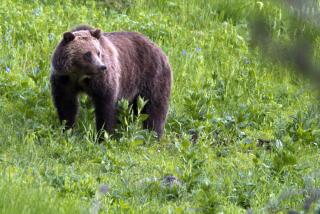Pre-human’s unusual diet gives researchers something to chew over
- Share via
A 2-million-year old hominid from South Africa had a very unusual diet, an international team of researchers has found. Instead of living on grasses and wild animals from the nearby savannas, like modern humans and pre-humans that have previously been studied, Australopithecus sediba lived on bark, woody tissues, fruits and other plants found almost exclusively in forests, like modern chimpanzees.
That diet may be one reason why the species died out, researchers said.
A. sediba was first discovered in 2008 in a pit at the Malapa Cave about 30 miles north of Johannesburg. Only about 4 feet tall, the creatures had an upright posture, long, gangly limbs, short fingers, a long thumb for gripping and a relatively complex brain compared with earlier species. Uranium dating of sediment covering the fossils places their age at about 2 million years.
A. sediba may have been a descendant of A. africanus, which was in turn a descendant of A. afarensis, a hominid that lived about 3 million years ago and is best known for the specimen known as Lucy. It is not clear if A. sediba is an ancestor of humans or a hominid offshoot that died out -- although the latter possibility seems more likely.
A team led by anthropologist Amanda G. Henry of the Max Planck Institute for Evolutionary Biology in Liepzig, Germany, studied the teeth from two A. sediba individuals, using a laser to blast minute amounts of enamel from the teeth for analysis in a mass spectrometer.
That allowed researchers to determine the relative amounts of the stable isotopes carbon-12 and carbon-13 in the tooth enamel that was laid down when the primates were young. Carbon-12 indicates that the hominids ate so-called C3 plants, which are mostly forest foods, such as as leaves and fruits. Carbon-13 indicates that they ate so-called C4 plants, savanna foods such as seeds, roots and grasses.
The team reported online in the journal Nature that they found primarily carbon-13, indicating that A. sediba consumed between 95% and 100% forest-based foods. In contrast, teeth from rodents and hoofed animals from the same region and period indicated that they were consuming mostly plants found on the grasslands.
These findings, the team said, help show why some early species thrived and continued to evolve, while others did not. “We know that if you are a hominid, in order to get to the rest of the world, at some point you must leave the forests, and our ancestors apparently did so,” said geochemist Benjamin H. Passey of Johns Hopkins University, a co-author. “The fates of those who did not leave are well known: they are extinct or, like the chimpanzee and gorilla today, are in enormous peril.” A. sediba apparently did not leave the forest.
Other evidence the researchers found supports this conclusion. Henry analyzed dental tartar found on the teeth and discovered fossilized particles of plant tissue known as phytoliths. The phytoliths suggest that, in the period before their deaths, the primates “were avoiding the grasses growing in open grasslands that were abundant in the region at the time,” Henry said.
Microscopic pits and scratches on the teeth also indicated that at least one of the hominids was eating harder foods, like nuts.
“What fascinates me are that these individuals are oddballs,” said co-author Matt Sponheimer of the University of Colorado at Boulder. “I had pretty well convinced myself that, after 4 million years ago, most of our hominid kin had diets that were different from living apes, but now I am not so sure.”
LATimesScience@gmail.com
twitter.com/@LATMaugh






